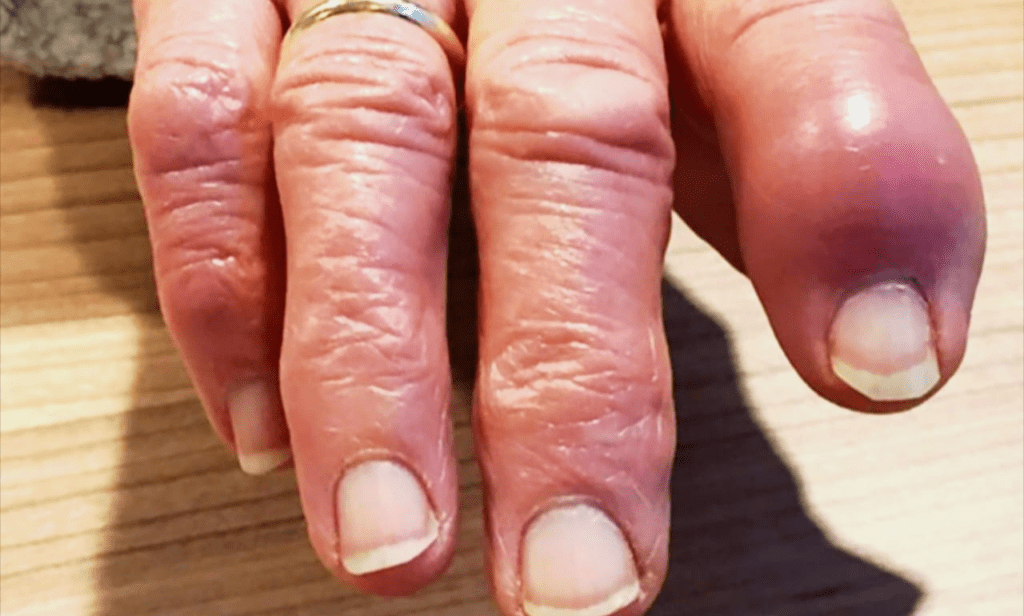
The man first brushed off the odd puffiness in his fingers and toes. Maybe it was fatigue, or perhaps he’d overdone it in the garden. But when his joints grew tender and his fingertips widened—blunting his ability to grip tools—he knew something was deeply wrong. His primary care physician was equally puzzled, noting the swelling resembled “clubbing,” a condition sometimes linked to heart or lung issues. Yet blood tests came back clean. As weeks passed, the discomfort sharpened into persistent pain. That’s when his doctor ordered X-rays. The images revealed a horror: where solid bone should’ve supported his hands and feet, ghostly holes and moth-eaten shadows appeared. Cancer had silently replaced healthy bone with destructive lesions.
This wasn’t arthritis or infection. Oncologists identified the swelling as hypertrophic osteoarthropathy (HOA)—a rare syndrome affecting bones and joints. HOA often masquerades as inflammatory arthritis but carries a sinister secret: in 80% of adult cases, it signals hidden cancer. For this patient, further PET scans confirmed stage IV lung cancer. Tumors in his chest had flooded his bloodstream with proteins that hijacked bone growth. One critical culprit? Vascular endothelial growth factor (VEGF), a substance that tumors excrete to build blood vessels. Excess VEGF triggers chaotic bone formation and breakdown, literally dissolving finger and toe bones while swelling soft tissues. Dr. Sarah Thompson, an orthopedic oncologist unconnected to the case, explains, “HOA is the body screaming for attention. The swelling isn’t just fluid—it’s cancer remodelling bone from the inside.”
Lung cancers cause 90% of HOA cases tied to malignancies. Squamous cell carcinoma—the type this patient had—is especially prone to secreting bone-altering compounds. By the time swelling appears, cancer has often spread. Research in the Journal of Thoracic Oncology shows 70% of such patients already have metastatic disease. Tragically, bone destruction like this man’s is irreversible. His surgeons couldn’t rebuild fingers devoured by lesions. Treatment shifted to chemotherapy and immunotherapy to attack the primary lung tumors. While these therapies can halt further bone damage, they’re rarely curative in advanced stages. The five-year survival rate for similar cases hovers near 5%.
Why do fingers and toes show damage first? These areas have dense networks of tiny blood vessels. Cancer-released proteins accumulate there, accelerating bone turnover. Normally, osteoblasts (bone-building cells) and osteoclasts (bone-removing cells) work in balance. Cancer tilts this equilibrium. Osteoclasts go rogue, resorbing bone faster than it can regenerate. X-rays reveal “lace-like” bones or even gaps where bone once existed—a process called osteolysis. Pathologists examining such lesions find them packed with cancer cells, not healthy tissue. “It’s like termites hollowing wood,” says Dr. Michael Rossi, a skeletal radiologist. “By the time swelling is visible, the bone may be 50% gone.”
This case underscores a vital lesson: unexplained swelling warrants imaging. Many patients endure months of misdiagnoses, like gout or rheumatoid arthritis. A 2023 review in BMJ Case Reports found that 62% of cancer-linked HOA cases are initially missed. Key clues differentiate HOA from benign causes: symmetrical swelling in multiple limbs, severe night pain, and skin changes like shiny or thickened fingertips. Dr. Elena Rodriguez, a rheumatologist, urges clinicians to “image swollen digits if pain persists beyond two weeks.” CT scans or MRIs can detect bone erosion early, potentially catching cancer before it spreads. For this patient, an earlier scan might have spared his bones, but his diagnosis came too late.
Beyond chemotherapy, treatments like bisphosphonates (bone-preserving drugs) or VEGF-blocking medications may shield surviving bone. In trials, drugs like zoledronic acid reduced skeletal complications by 40% in similar cases. Yet prevention remains paramount. Smokers face 20x higher lung cancer risk, and quitting can lower the risk within a few years. The American Cancer Society emphasizes annual low-dose CT scans for high-risk groups—those over 50 with a 20-pack-year smoking history. These screenings cut lung cancer deaths by 24%. For nonsmokers like this patient (a lifelong non-smoker), genetic testing or exposure histories (like radon) become critical.
His story rippled through oncology circles. Cases like his—documented in journals like Radiology—teach doctors to spot “silent” cancers through skeletal changes. As research accelerates, blood tests detecting VEGF or similar proteins could one day flag HOA before bone loss occurs. For now, vigilance saves lives. That stubborn swelling? Don’t ice it or ignore it. Insist on imaging. Cancer that devours bone won’t stop at fingers.
